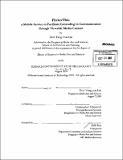| dc.contributor.advisor | Christopher Schmandt. | en_US |
| dc.contributor.author | Lin, Dori Tung-Yun | en_US |
| dc.contributor.other | Massachusetts Institute of Technology. Dept. of Architecture. Program in Media Arts and Sciences. | en_US |
| dc.date.accessioned | 2010-05-25T21:02:29Z | |
| dc.date.available | 2010-05-25T21:02:29Z | |
| dc.date.copyright | 2009 | en_US |
| dc.date.issued | 2009 | en_US |
| dc.identifier.uri | http://hdl.handle.net/1721.1/55193 | |
| dc.description | Thesis (S.M.)--Massachusetts Institute of Technology, School of Architecture and Planning, Program in Media Arts and Sciences, 2009. | en_US |
| dc.description | Cataloged from PDF version of thesis. | en_US |
| dc.description | Includes bibliographical references (p. 73-75). | en_US |
| dc.description.abstract | Remote communication has become part of our daily lives. Technology plays a decisive role in filling the gap caused by discrepancies in time and space between us and the people we want to reach. However, the level of immediacy and interactivity are always lacking when compared to face-to-face communication. In most cases, the desire to communicate is postponed or abridged to nonreciprocal sharing, especially when time differences are taken into account. Limited bandwidth also increases the likelihood of a misunderstanding occurring during a remote conversation. Confronting the limitations of remote communication, FlickerThis is a mobile service that facilitates grounding in communication through viewable content. Different from most communication services that rely on isolated channels to push information out, FlickerThis adapts the essential perceptions, seeing and hearing, in face-to-face communication to mediate remote communication. With photos taken by a camera phone and audio narration as the intuitive input, FlickerThis messages are composed to become stories whenever one has an intention to communicate with others. Users can talk over the phone while flipping through a virtual photo album together, or they can record and send voicemails embedded with pictures. Therefore, FlickerThis enables remote communication to switch between synchronous and asynchronous modes, and uses viewable content to enhance mutual understanding. | en_US |
| dc.description.statementofresponsibility | by Dori Tung-Yun Lin. | en_US |
| dc.format.extent | 75 p. | en_US |
| dc.language.iso | eng | en_US |
| dc.publisher | Massachusetts Institute of Technology | en_US |
| dc.rights | M.I.T. theses are protected by
copyright. They may be viewed from this source for any purpose, but
reproduction or distribution in any format is prohibited without written
permission. See provided URL for inquiries about permission. | en_US |
| dc.rights.uri | http://dspace.mit.edu/handle/1721.1/7582 | en_US |
| dc.subject | Architecture. Program in Media Arts and Sciences. | en_US |
| dc.title | FlickerThis : a mobile service to facilitate grounding in communication through viewable media content | en_US |
| dc.title.alternative | Mobile service to facilitate grounding in communication through viewable media content | en_US |
| dc.type | Thesis | en_US |
| dc.description.degree | S.M. | en_US |
| dc.contributor.department | Program in Media Arts and Sciences (Massachusetts Institute of Technology) | |
| dc.identifier.oclc | 609404850 | en_US |
